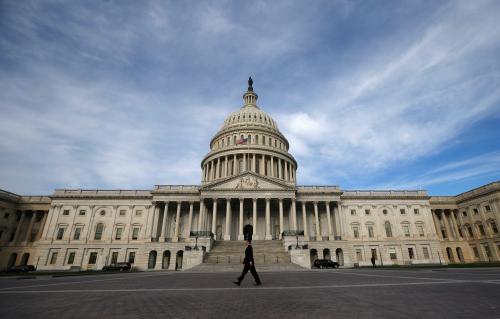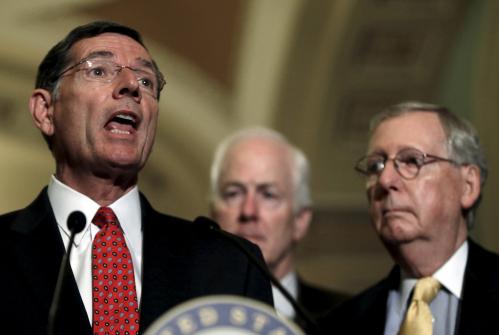The Senate passed its version of the Republican tax bill early Saturday morning 51-49, with only one Republican—Tennessee Senator Bob Corker—joining all Democrats in voting no. Had trouble keeping all its moving parts straight? Here are four lessons to take away from what we’ve seen in the Senate:
1. All reconciliation bills aren’t created equal.
Earlier this year, Republicans also used the filibuster-proof reconciliation process for their unsuccessful health care bill. When we compare the Senate’s experience with the two bills, we can see some important differences between using the procedures to make changes to tax code versus to government programs. As anyone who watched either legislative debate closely knows, reconciliation isn’t an unlimited tool. Importantly, the Byrd Rule imposes limits on how the process can be used in several ways. If we think of a reconciliation bill as a box, some components of the Byrd Rule restrict what can go in the box. Other parts of it determine the size of the box in deficit terms, including a prohibition on any increase to the deficit from the bill after an initial period (in this case, ten years) is up.
While most of what tripped up Republicans on health care this summer was substantive disagreement about what should be in the bill, the question of whether particular proposals, such as changes to insurance market regulations, were allowed to be put in the reconciliation box was an important and recurring feature of the debate. On the tax bill, however, the relevant limits were more about the size of the box. This changes the nature of bargaining with individual senators as party leaders try to build a coalition. Rather than being an issue of whether a demand can be included in the bill at all, it becomes an issue of what else needs to be changed to accommodate the demand. That can make coalition-building easier.
2. Reconciliation isn’t just about what happens on the floor.
When we talk about the budget reconciliation procedures, we usually focus on the biggest way that they differ from the regular legislative process: by limiting debate on a bill to 20 hours in the Senate, they prevent the possibility of a filibuster. Important components of the reconciliation process occur before the bill ever makes it to the Senate floor. One of those steps involves the drafting of the reconciliation instructions as part of the annual congressional budget resolution; the instructions help define the size of the reconciliation box discussed in #1. Without an agreement on those instructions, Congress can’t avail itself of reconciliation’s other procedural benefits. Republicans on the Senate Budget Committee—which is responsible for writing the reconciliation directives—began the process with disagreement on what those instructions should look like. An agreement between Senators Pat Toomey (R-Pa.) and Bob Corker (R-Tenn.) back in mid-September, however, was pivotal to setting up the underlying framework that allowed Republicans to proceed on a party line basis. In addition, the decision to include instructions to the Energy and Natural Resources Committee meant that the bill could include provisions related to drilling in the Arctic National Wildlife Refuge. That, in turn, helped solidify the support of Senator Lisa Murkowski (R-Alaska), who had voted against Republicans’ health care bill earlier this year.
3. Reconciliation doesn’t just turn the Senate into the House.
While the reconciliation process does relieve the Senate’s majority party of the need to build a supermajority coalition to overcome the threat of a filibuster, it does not simply make the upper chamber a mirror of the lower house. With their longer terms and longer constituencies, the electoral realities facing senators are different than those confronting House members. Staggered electoral cycles also mean that the majority party’s task of maintaining control of the Senate can look very different from cycle to cycle.
Given that the content of reconciliation bills is often shaped by the majority party’s electoral needs, it’s not surprising that these institutional differences between the chambers have consequences for how specific policy matters were treated by the House and the Senate. Take, for example, the significant focus in the House on the state and local tax deduction. Reaching a compromise on that issue was a major obstacle to be cleared before House passage, in part because there was a sizable bloc of potentially vulnerable House Republicans whose constituents rely heavily on the deduction. For Republican senators, however, the issue is less salient, so they were more willing to entertain a full repeal of the deduction. And when a compromise provision on the issue was ultimately incorporated into the Senate’s bill at the last minute, it was championed by Senator Susan Collins of Maine—whose constituents take the deduction more than many other GOP senators.
4. Speed matters—but not just for getting to ‘yes.’
Much has been made of the speed at which congressional Republicans have proceeded with the tax bill, and there are certainly political reasons why quick action was a key part of the GOP’s strategy. Beyond the desire to get a political win in the first year of the Trump administration, and any concerns about the results of the coming special election in Alabama, developing bills behind closed doors and moving them quickly are an important way that party leaders try to control the legislative process. But the biggest consequences of speedy passage might not be realized until after the bill is finished. A rushed process can produce errors in legislation and creates the possibility for unintended consequences, especially in a policy area as complicated as the tax code.
The tax bill still has at least one hurdle to clear before it reaches President Trump’s desk. The House has scheduled a vote to go to conference on the bill on Monday. While that is a signal that the House leadership currently intends to engage in negotiations with the Senate, it remains possible that the lower chamber will simply accept what the upper house has already passed. With a range of other issues—including avoiding a government shutdown, disaster relief funding, the expired Children’s Health Insurance Program, and action on immigration—on the congressional agenda, Republicans would clearly like to finish the tax bill as quickly as possible. We’ll see if they keep up the pace.










Commentary
Four lessons from the Senate tax bill
December 2, 2017